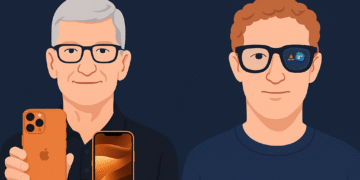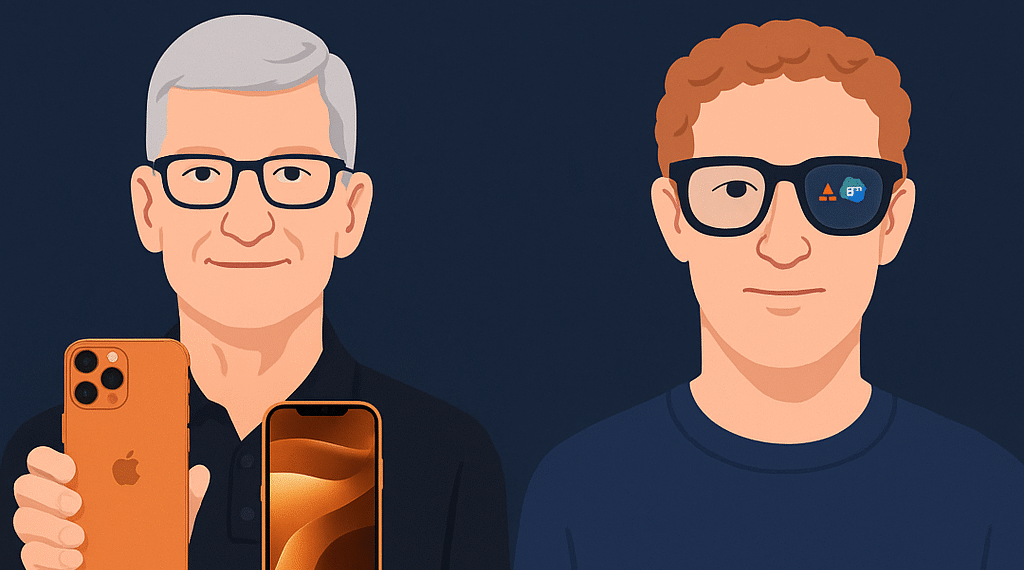Apple’s iPhone 17 vs. Meta’s AI Glasses
Technology never stands still. Each year, we witness a new wave of innovation that not only excites consumers but also reshapes industries, shifts economies, and changes the way we live. Two of the most influential players in today’s digital revolution—Apple and Meta—are taking radically different approaches to defining the future. On one hand, Apple continues to perfect the smartphone experience with the anticipated iPhone 17, a device that represents years of refinement, hardware excellence, and ecosystem mastery. On the other, Meta is betting on an entirely different future with AI-powered smart glasses, aiming to challenge the very concept of what a “phone” means.
The clash between these two visions is more than just a battle of devices; it is a reflection of where humanity is heading. Will we continue holding powerful slabs of glass and metal in our hands, or will the future move to something lighter, more immersive, and hands-free—powered by artificial intelligence, wearable design, and cloud integration?
Let’s dive into this fascinating comparison between Apple’s iPhone 17 and Meta’s smart AI glasses, while also exploring the underlying technologies, market implications, and the broader motivation behind this new digital frontier.
The iPhone Legacy: Evolution of the Ultimate Smartphone
When Apple introduced the first iPhone in 2007, it changed the world forever. For the first time, a device could combine phone calls, internet browsing, music, and photography into one seamless experience. Over the years, Apple has mastered the art of innovation within an ecosystem. Each iteration of the iPhone refined design, performance, and user experience.
By the time the iPhone 17 launches, it will represent nearly two decades of perfection in smartphone engineering. Expectations for this device are high: faster processors, advanced AI chips, a camera system rivaling professional DSLRs, and seamless integration with Apple’s services. Apple has been pushing its A-series chips, and with the rise of on-device AI, the iPhone 17 is expected to have neural engines capable of handling real-time translations, advanced image recognition, and even generative AI features without depending too much on cloud servers.
Beyond hardware, what makes the iPhone unique is the ecosystem lock-in—the App Store, iMessage, FaceTime, Apple Pay, Apple Watch, and the tight integration with macOS and iPadOS. Owning an iPhone is not just about the device; it is about being part of a digital lifestyle that millions cannot imagine leaving.
But here lies the critical question: Is this form factor—the slab of glass we hold and stare at—going to remain dominant forever? Or are we on the verge of a paradigm shift?
Meta’s Bold Bet: Smart AI Glasses
While Apple builds upon its proven model, Meta is trying to redefine the future. Through its partnership with Ray-Ban, Meta has already launched smart glasses that combine cameras, microphones, and speakers with real-time AI assistance. The vision is simple but revolutionary: instead of taking out your phone to look at a screen, why not have the information overlaid on your vision or whispered into your ear?
The latest iteration of Meta’s glasses brings AI directly into the frame. Imagine walking down the street and asking your glasses: “What’s the best route to the train station?” Instead of pulling out a phone and unlocking it, the glasses instantly respond. Or picture being in a foreign country and having live translation whispered to you without ever breaking eye contact with the world.
Meta is betting on ambient computing—a future where technology fades into the background and becomes an invisible assistant. This is a powerful idea. For decades, humans have bent their posture, strained their eyes, and glued their attention to rectangular screens. If AI-powered wearables can break that habit and offer the same or better functionality, they could indeed threaten the smartphone’s dominance.
However, the glasses today are not yet a complete replacement. They don’t have cellular connectivity in the way a phone does, they rely heavily on cloud AI, and their app ecosystem is far smaller than the iPhone’s. But technology adoption is rarely immediate—it evolves in steps. The first iPhone lacked 3G, lacked the App Store, and even lacked copy-paste. Yet it changed everything. Meta hopes its AI glasses will follow a similar trajectory.
The Power of AI: The True Disruptor
The real story here is not the hardware—it is artificial intelligence. Both Apple and Meta know that the next great leap in technology will be defined by AI’s role in our daily lives.
Apple is embedding AI into the iPhone as a personal companion: smarter Siri, real-time photo editing, predictive health monitoring, and enhanced productivity apps. Apple’s approach is typically cautious but refined—ensuring privacy through on-device processing while gradually scaling capabilities.
Meta, in contrast, is taking a bolder, cloud-first AI approach. Its glasses are essentially a wearable interface for Meta AI, capable of answering questions, analyzing surroundings, generating captions, and even identifying objects in real-time. This turns every user into a kind of cyborg—augmenting human senses with machine intelligence.
The difference in philosophy is clear: Apple sees AI as an assistant within a trusted device, while Meta sees AI as an ever-present companion woven into everyday life. The stakes couldn’t be higher, because the one who defines how humans interact with AI will set the stage for the next digital era.
Can Glasses Really Replace Smartphones?
This is the question at the heart of the debate. Smartphones are entrenched in modern life. They handle not just communication, but also banking, navigation, entertainment, photography, identity verification, and more. Replacing them isn’t as simple as launching a new gadget.
For Meta’s AI glasses to replace smartphones, several technological and social challenges must be solved:
- Battery Life: Glasses must run powerful AI tasks and display systems without overheating or dying in hours.
- Display Technology: True AR overlays must be bright, sharp, and comfortable, rivaling the clarity of phone screens.
- Connectivity: Built-in cellular, 5G/6G, and satellite integration will be essential for independence from phones.
- Privacy Concerns: Cameras on glasses raise concerns about surveillance, consent, and data security.
- Ecosystem Apps: Just as the iPhone’s App Store fueled its growth, AI glasses need developers to build innovative apps.
- Social Acceptance: People must feel comfortable wearing them in public, just as they eventually did with smartphones.
If these challenges are met, the potential is enormous. Imagine a world where your glasses project a virtual monitor in front of you, replacing your laptop. Or where your AI glasses quietly remind you of someone’s name during a meeting. Or even where immersive AR gaming happens anywhere you look.
This isn’t science fiction—it’s a roadmap already being built by companies like Meta, Apple (with Vision Pro), Google, and Microsoft. The only question is: who will get there first?
The Market Impact: Disruption or Coexistence?
If Meta succeeds, the smartphone market could face its first real disruption in two decades. A successful AI glass product priced around $800 would be cheaper than many flagship smartphones and might appeal to younger generations eager to adopt new trends.
Apple, of course, is not blind to this shift. Its Vision Pro headset is the company’s first step into mixed reality. Although it is bulky and expensive today, the long-term plan is clear: Apple wants to move from iPhones to lightweight AR glasses that integrate seamlessly with iCloud, Apple Pay, and the broader Apple ecosystem. In other words, both Apple and Meta see the same future—only their entry points differ.
The most likely outcome in the near future is coexistence. Smartphones will remain essential while AI glasses grow as a companion device. Over time, as technology improves, we may reach a tipping point where glasses or other wearables become the primary interface, just as smartphones replaced feature phones and PCs for many tasks.
The Motivation Behind It All
At the heart of this battle lies a deeper motivation: the human desire for freedom and augmentation. For centuries, technology has been about extending our capabilities—fire, the wheel, electricity, the internet. Smartphones extended our brains into the cloud, but they also trapped our eyes and posture into glowing rectangles.
AI glasses promise liberation: the ability to look up, walk freely, and still have the world’s knowledge at your command. They promise a future where our technology is less intrusive but more powerful, less visible but more intelligent. This vision is deeply motivating, because it aligns with the natural human drive for convenience, power, and seamless living.
And yet, this motivation comes with responsibility. AI is not just a tool; it is a force that will shape societies, economies, and ethics. Privacy, data rights, and digital addiction are challenges we must face head-on. The companies leading this revolution must balance profit with humanity’s long-term well-being.
Conclusion: The Next Chapter of Human-Tech Evolution
The comparison between Apple’s iPhone 17 and Meta’s AI glasses is not just about gadgets. It is about two competing visions of the future. One represents mastery of the present—a perfected smartphone ecosystem. The other represents a leap into the unknown—a wearable AI-driven interface that could one day replace phones entirely.
History shows us that technology always evolves faster than expected. Twenty years ago, few imagined the smartphone would become the center of human life. Twenty years from now, we may look back at today and laugh at the idea of holding devices in our hands. Perhaps the real revolution will be invisible—worn on our faces, whispered in our ears, or embedded in our environment.
Apple and Meta are leading us into that future from different directions. Whether we remain phone users or transition to AI glasses, one thing is certain: humanity is on the edge of another technological transformation. And for those who embrace it, the possibilities are limitless.
















